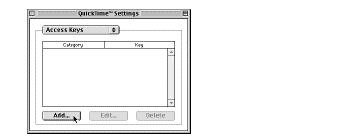
QuickTime 3 Reference
This section explains how to use access keys.
Listing 14 illustrates how to register an application access key.
Listing 14 Registering an application access key
OSErr myErr = 0;
Str255 keyType = doomCDKeyType;
long flags = AccessKeySystemFlag;
handle keyHdl;
myErr = PtrToHand ((Ptr)"keykeykey", &keyHdl, sizeof("keykeykey")-1);
myErr = QTRegisterAccessKey (keyType, flags, keyHdl);
Listing 15 illustrates how to register a system access key.
Listing 15 Registering a system access key
OSErr myErr = 0;
Str255 keyType = doomCDKeyType;
long flags = 0;
handle keyHdl;
myErr = PtrToHand ((Ptr)"keykeykey", &keyHdl, sizeof("keykeykey")-1);
myErr = QTRegisterAccessKey (keyType, flags, keyHdl);
Listing 16 illustrates how to unregister a system access key.
Listing 16 Unregistering an access key
OSErr myErr = 0;
Str255 keyType = doomCDKeyType;
long flags = AccessKeySystemFlag;
handle keyHdl;
myErr = PtrToHand ((Ptr)"keykeykey", &keyHdl, sizeof("keykeykey")-1);
myErr = QTUnRegisterAccessKey (keyType, flags, keyHdl);
Listing 17 illustrates how a decompressor can get application access keys of a particular type.
Listing 17 Getting access keys
OSErr myErr = 0;
Str255 keyType = doomCDKeyType;
long flags = 0;
handle keyHdl;
myErr = PtrToHand ((Ptr)"keykeykey", &keyHdl, sizeof("keykeykey")-1);
myErr = QTGetAccessKeys (keyType, flags, keyHdl);
Users can enter, edit, and delete system access keys in the QuickTime control panel. The controls for these operations are illustrated in Figure 10 , Figure 11 , and Figure 12 .
Figure 10 Click the Add button to add an access key

Figure 11 Next, enter the category (key type) and key, then click OK

Figure 12 When you're done, there's a key that can be edited or modified
